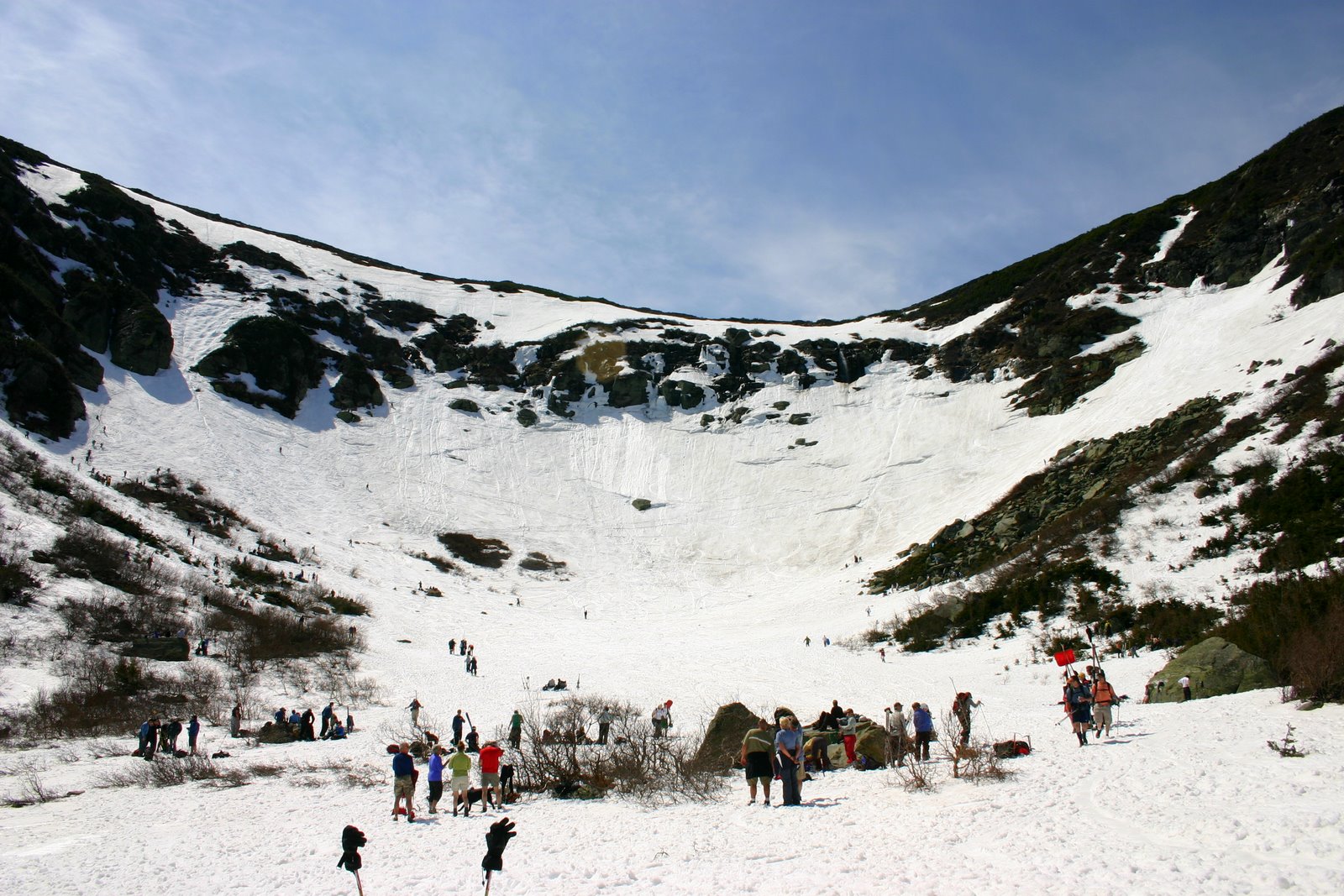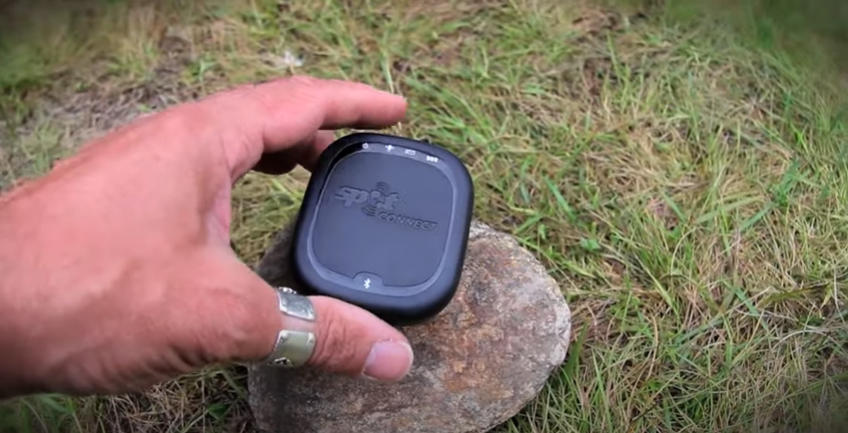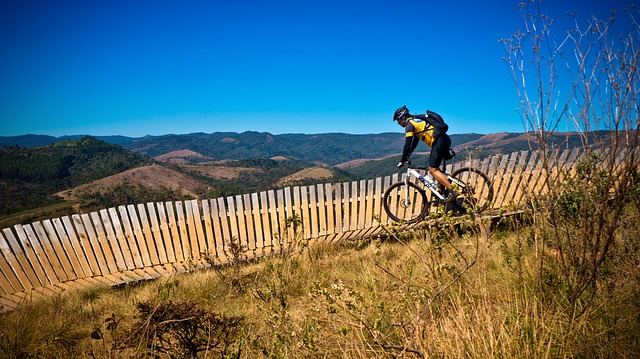It’s foggy and windy, my feet are soaked through and I’m cold to the bone.
Jeff Hofer, Johnny Poole and I have been hiking up the trail for three miles. The Appalachian Mountain Club calls it a trail, yet it feels more like a waterfall of rocks. The weather was sunny then cloudy, changed to rain then back to sun. Now it’s just miserable.
But I’m in good spirits. I’m with friends and Tuckerman’s Ravine is close. I can feel it. The trees are getting smaller and the wind is getting stronger.
Soon we see a couple slogging towards us, carrying their skis down the trail.
“What’s the deal up there?” Johnny asks.
“It was just too much,” the guy says. “Too hard to see.”
“It’s no good,” the woman says.
They must be nuts. They hiked all this way with heavy gear to turn around and not cut any turns in the snow? It can‘t be that bad.
Then again, this is Mount Washington, a New Hampshire mountain infamous for some of the worst weather in the world.
Conditions were definitely better when Jeff, Johnny and I hiked Tuckerman’s thirteen years ago.
It was late spring of 1997. We were nineteen years old, fresh out of our first year of college. Jeff and I drove up from Pennsylvania and met Johnny in New Hampshire, who was finishing a term paper as we geared up and scrambled out the door headed north.
Johnny had sent me the post card the previous autumn. Tuckerman’s Ravine was his idea, and the impressive photo on the front of the card lured me in. On the back he wrote a simple question – “What do ya say we hit this shit!” I knew Jeff would come too. The three of us had been friends since we were young and skiing together was important to us.
We were ready for something more challenging, each having lived a year away from home we felt the need to experience the true meaning of “hiking in” to earn a skier’s descent.
A glacial cirque carved out of the east side of Mt. Washington, Tuckerman’s averages over 50 feet of snowfall each year. It was first skied in April of 1914 by John Apperson, a climber, skier and conservationist, from Schenectady, New York. It is the birth place of extreme skiing in the United States.
Since then, each spring from early April to late May, it has served as a last refuge for New England skiers willing to hike three miles of rugged trails for a last winter rush as they careen down the walls of the cirque’s steep headwall.
That first trip it was not perfect weather, but it was clear and dry. A crowd of hikers ate lunch on the rocks at the bottom of the ravine, watching skiers climb the headwall face of the ravine and ski back down.
We’d trudged up the snow-covered headwall in our ski boots, skis slung over our left shoulders to help us balance on the 45° angle slope.
For the most part, the ascent line on the headwall is clear of rocks, but you have to watch out for falling ice and climbers with thrashing skis from above. It is easy to lose your footing, though, and people often fall and slide down the slope, typically unharmed.
That day we conquered the ravine with only one fall. As Johnny tumbled from the trail and slid down the face we watched him disappear into clouds that had moved in. He was defeated but uninjured. Jeff and I topped out, bombed down the headwall and shot out across the ravine floor. We had earned our descent, taken our lumps – in Johnny’s case – and joined a long tradition.
Now it’s May 2010 and we’re back for another go.
Johnny Poole, Jeff Hofer and Rob Kalmbach headed for the infamous weather of New Hampshire’s Mount Washington for the first time in over a decade.
The last time the three of skied together was 5 years ago, when we spent a soggy week in Whistler, British Columbia. I think it was Johnny who concocted the plan to return to Tuck’s. I’d flown from Los Angeles to Philadelphia, where I met Johnny. On the way north, we picked up Jeff, who’d recently started graduate school at University of Massachusetts. Last night, we slept at Joe Dodge Lodge, in Gorham, New Hampshire, where the trail begins.
As we hike up the trail, we get no break from sogginess. Despite the bad weather, we have plans to reach the headwall again, climb it and ski down. We’re determined, but this is a different Mount Washington than we experienced 13 years ago. Among other things, my ski pants are soaked through and my legs are freezing.
We are each carrying backpacks loaded with ski boots, extra jackets, water and lunch for the day. Our skis are tethered to the sides of our packs and form triangular halos over our heads. We each carried at least 20 pounds with ski poles in hand.
We make it to Hermit Lake Shelter, a small outpost before the ravine. As we huddle on the outdoor deck in the fog, a ski patrolman warns us that conditions ahead are terrible. We cram inside the hut for a moment to hide from the howling wind and warm ourselves. I tell Jeff that I don’t know what we are supposed to do when we get up the ravine.
“This is fucked up,” Johnny says.
“Yeah,” I reply. “Is anyone even going up?”
Jeff says we may not ski, but we’re going to climb and that’s all that matters. I feel better. I open up the hoagie I brought and take a few bites.
There’s a young guy in the hut, maybe 20 years old, who says he’s making his first attempt at Tuck’s. He came completely unprepared. His pack looks empty and he’s wearing shorts. But he’s happy to be there.
Jeff reminds me that on our last adventure here, I failed to pack a proper jacket and had borrowed one from a random person in Johnny’s dorm at University of New Hampshire.
We leave the hut and start climbing. It gets colder and the visibility gets worse. Each step feels like a small victory. When we get to the rocks below the ravine headwall, the spot where all the hikers were picnicking last time, I barely recognize the place.
The snowpack is thin. Johnny thinks he hears a river or a waterfall, but it turns out to be rushing water under the snow.
In some areas large round snow balls perch oddly on pedestals of snow. Tuckerman’s Ravine looked like Mars.
Another group of three skiers heads up, including an older gentleman wearing blue jeans. Johnny, Jeff and I exchange glances. In the Poconos, where we grew up skiers in blue jeans were a common sight. Here, in these conditions, it looks especially funny and very uncomfortable.
If this crew can do it, surely we can.
We follow them up to the left gully of Tuckerman’s. A skier falls out of the clouds. His skis scrape the grainy spring snow as he makes tight turns, then go silent as he straightens out and flies past us.
The climb up the gully is treacherous, and we have to kick our ski boots into the snow each new step. We are ascending a narrow chute and there are rocks below us on either side. I’m glad to be wearing a helmet, for warmth and for protection.
Pretty soon the wind lets up and we find ourselves leaning against a glorious steep. We’re climbing the headwall again. I am more nervous this time, but equally thrilled. I imagine the sun coming out, but it isn’t going to happen.
I lead the way, followed by Jeff then Johnny. We come to a tiny island of rocks and trees not far from the top of the headwall. We climb onto the rocks like they are dry land and we’ve been out at sea for days.
Even as we step onto this small respite, I’m afraid of falling down the chute. We haven’t made the summit but we’re very close. It’s enough.
Tired and wet we abandoned the island of rocks and point our skis down the headwall. After all the planning, traveling, packing and climbing, the reward is sweet. We drop into a place where very few go, and for the next three minutes, we cut turns.
I ski down the steep gully with my two old friends close at hand and together we shoot out onto the bottom of the ravine. We did it again. We did that shit.
This page is an archive. To learn more about archive pages click here
The responses below are not provided, commissioned, reviewed, approved, or otherwise endorsed by any financial entity or advertiser. It is not the advertiser’s responsibility to ensure all posts and/or questions are answered.




